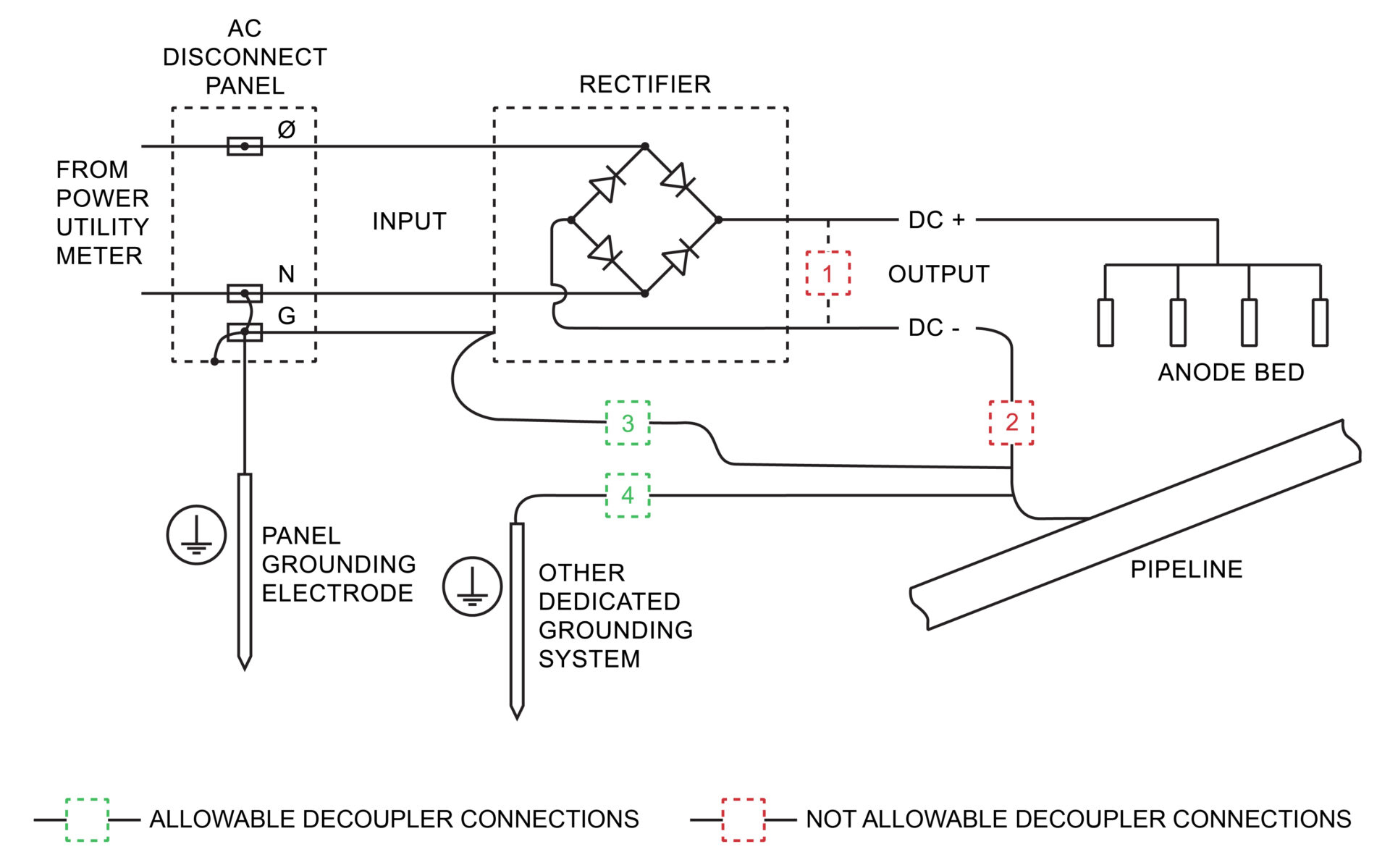Technical Article
Allowable Decoupler Connections at Rectifiers
Decouplers may, at times, be connected at rectifier installations for various purposes of over-voltage protection, AC mitigation, or in an attempt to protect a rectifier from failure (e.g. lightning, AC faults). Decouplers are DC blocking/AC conducting devices, rated for AC fault and lightning conditions, and are commonly used for AC voltage mitigation on pipelines as well as over-voltage protection, while normally blocking cathodic protection current on CP systems. So which decoupler connections are allowable, and which are not?
Reference the figure below and refer to the numbered decoupler locations that have been proposed for discussion of acceptable locations and purposes.

Location 1: In this situation, a customer has proposed to connect a decoupler between the negative and positive DC output connections at the rectifier, in an attempt to mitigate induced AC on the pipeline or to provide rectifier protection from lightning conditions. As the anode bed is a low resistance ground, this may seem tempting from an AC mitigation perspective. However, this connection is not allowable. Decoupler thresholds are typically 2 to 3V, while the DC output at the terminals of the rectifier is typically set at tens of volts – well in excess of the decoupler threshold. This would instantly cause the decoupler to fully conduct upon connection and would cause the rectifier’s overcurrent protection to activate (breaker or fuse), tripping the rectifier off line. AC mitigation should be accomplished to a separate grounding system – not the rectifier’s anode bed. Lightning protection can be accomplished in other ways, possibly in Location 3, discussed below, or in other Dairyland documents.
Location 2: Here, a customer has proposed to locate a decoupler in series in the negative connection from the pipeline to the rectifier, with the thought of providing some type of over-voltage protection to the rectifier. This location would be totally inappropriate, as decoupling devices inherently block DC, which is in opposition to the need to have direct current flow in this connection to create an operative cathodic protection system. There is no variation of this proposed installation that is allowable. Likewise, the decoupler cannot be installed in series in the positive cable for any reason.
Location 3: For the purpose of AC mitigation, a decoupler may be installed at this location, connected to the rectifier cabinet and site electrical grounding system. This can provide local pipeline AC mitigation and will keep the pipeline referenced to the electrical grounding system for safety. As the local grounding system is typically also bonded to the utility distribution grounding system, this provides an extensive, low resistance connection for the purpose of AC steady-state and fault mitigation. This installation may possibly also provide protection for overvoltage events that could damage a rectifier, however more comprehensive protection may be needed to address over-current conditions during a lightning event and not just over-voltage. This installation may assist with rectifier operation where DC output is affected by steady-state AC induction. Before installing a decoupler in this location, be sure to check that the voltage between the negative rectifier output and the ground connection is compatible with the decoupler’s threshold voltage. Contact Dairyland if rectifier protection is the main focus.
Location 4: This is a variation of Location 3, with connection to a dedicated and isolated grounding system, typically for the purpose of AC mitigation. This has generally the same effect as Location 3, however it may not be able to achieve the low resistance of Location 3, unless an extensive grounding system is installed.
Summary
Decouplers are flexible devices that can be used in multiple locations on CP systems. Knowing how decouplers are properly installed at rectifiers can be confusing, but Dairyland is here to help. For code-covered connections, it is advisable to contact a licensed electrician to ensure that any connections or electrical grounding systems are properly designed and installed.
Dairyland Electrical Industries application engineers are available to assist with selecting the proper decoupler and optimal configuration to achieve the desired results for this, and other, applications where decoupling may be necessary.
Contact Dairyland’s technical support team at: techsupport@dairyland.com.
Want To Dive Deeper?
Join One of Our Learning Events.
Our event schedule provides you the in-depth product and application training you need to correctly apply Dairyland products.